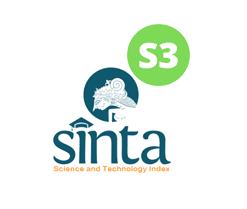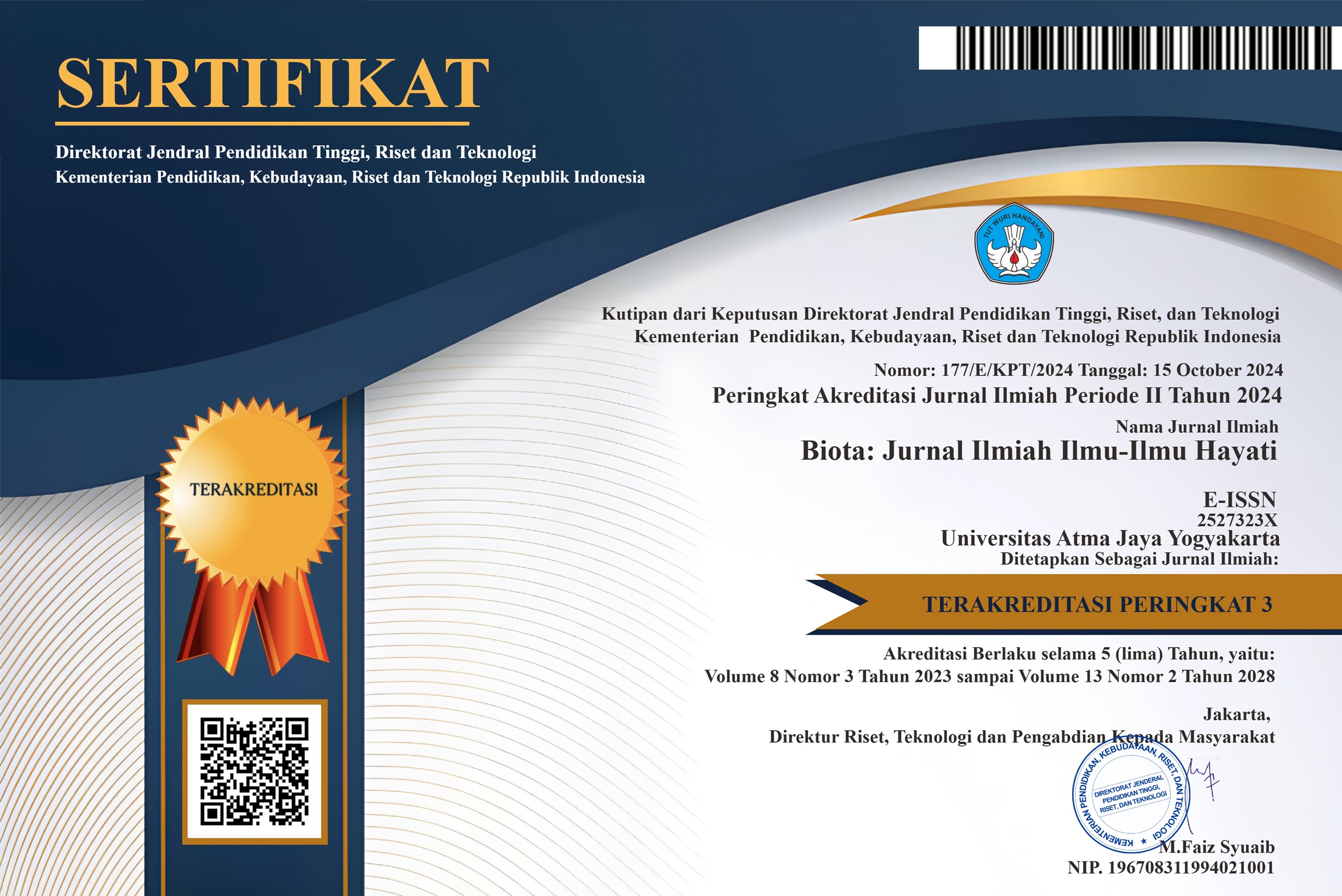Isolasi dan Identifikasi Khamir Toleran Alkohol dari Molase
DOI:
https://doi.org/10.24002/biota.v7i1.5426Keywords:
alkohol, molase, karakterisasi, yeast toleran alkohol, PCR, sekuensing DNAAbstract
Khamir mampu menghasilkan bioetanol dari molases. Selama proses produksi (proses fermentasi) terjadi proses akumulasi alkohol sehingga konsentrasi alkohol semakin meningkat. Konsentrasi etanol yang melebihi 8% (v/v) dapat menyebabkan ketidakstabilan membran yang kemudian dapat menurunkan permeabilitas membran dan homeostasis sel. Penelitian ini dilakukan isolasi dan identifikasi khamir indigenus dari molase yang toleran terhadap alkohol. Karakterisasi morfologi meliputi bentuk koloni, bentuk sel dan tipe pertunasa, sedangkan karaktersasi fisiologis dilakukan dengan kit API 20C. Identifikasi molekuler dilakukan dengan PCR dan sequencing DNA menggunakan primer ITS1-ITS4. Hasil penelitian didapatkan dua isolat khamir yaitu isolat X dan Z yang memiliki potensi toleran terhadap alkohol. Berdasarkan hasil karakteristik fisiologis, isolat X dan isolate Z memiliki kedekatan dengan Candida tropicalis. Hasil sequencing DNA dengan primer ITS1-ITS4 dan analisis dengan program blastn menunjukkan bahwa isolat X teridentifikasi sebagai spesies Candida parapsilosis strain AUMC 10714 dan isolat Z teridentifikasi sebagai spesies Candida parapsilosis ZA012.
References
Amrutkar , S. M ., Banoth, Linga., & Banerjee, U.C. (2013). One-pot synthesis of (R)-1-(1-naphthyl)ethanol by stereoinversion using Candida parapsilosis. Tetrahedron Letters 54(25): 3274–3277.
Betz, C., Schlenstedt, G., & Bailer, S.M. (2004). Asr1p, a novel yeast ring ⁄ PHD finger protein, signals alcohol stress to the nucleus. Journal of Biology and Chemistry 279: 28174–28181.
Calderone, R.A. (2002). Candida and Candidiasis. ASM Press. Washington.
Chadha, V.P, & Padhi. (2016). Candida parapsilosis: A versatile biocatalyst for organic oxidation-reduction reactions. Bioorganic Chemistry 68: 187-213.
Daum, G., Lees, N.D., Bard, M., & Dickson, R. (1998). Cell biology and molecular biology of lipids of Saccharomyces cerevisiae. Yeast 14: 1471-1510.
Fitriyah, I., Sugiharto, B., & Jayus, J. (2018). Isolation and Identification of Osmophilic Yeasts Isolated from Molasses Sugarcane as Bioethanol Starter. Advances in Engineering Research 172
Fujita, S., Senda, Y., Nakaguchi, S., & Hashimoto, T. (2001). Multiplex PCR using Internal Transcribed Spacer 1 and 2 regions for rapid detection and identification of yeast strains. Journal of Clinical Microbiology 39 (10): 3617-3622.
Gibson, B.R., Lawrence, S.J., Leclaire, J.P., Powell, C.D., & Smart, K.A. (2007). Yeast responses to stresses associated with industrial brewery handling. FEMS Microbiol Rev 31:535-569.
Hu, C.K., Bai, F.W., & An, L.J. (2005). Protein amino acid composition of plasma membranes affects membrane fluidity and thereby ethanol tolerance in a self-flocculating fusant of Schizosaccharomyces pombe and Saccharomyces cerevisiae. Chinese Journal of Biotechnology 21: 809-813.
Jayus, J., Mayzuhroh, A., Arindhani, S., & Caroenchai, C. (2016). Studies on bioethanol production of commercial baker's and alcohol yeast under aerated culture using sugarcane molasses as the media. Agriculture and Agricultural Science Procedia 9: 493-499.
Kelley, M.J., Bailis, A.M., Henry, S.A., & Carman, G.M. (1988). Regulation of phospholipid biosynthesis in Saccharomyces cerevisiae by inositol. Inositol is an inhibitor of phosphatidylserine synthase activity. Journal of Biology and Chemistry 263: 18078-18085.
Kumamoto, C.A. (2002). Candida biofilms. Curr Opin Microbiol 5: 608-611.
Lloyd, D., Morrell, S., Carlsen, H.N., Degn, H., James, P.E. & Rowlands, C.C. (1993). Effects of growth with ethanol on fermentation and membrane fluidity of Saccharomyces cerevisiae. Yeast 9(8): 535-569.
MacPherson S, Larochelle M. & Turcotte, B. (2006). A fungal family of transcriptional regulators: the zinc cluster proteins. Microbiology Molocular Biology Rapid 70: 583–604.
Nakase, Takashi., Fukazawa, Yoshimura., & Tsuchiya, Takeshi. (1972). A Comparative Study on Two Forms of Gandida Tropicalis (Cast.) Berkhout. The journal of General and Applied Microbiology 18(5): 349-363.
Nurhayati, N., Sugiharto, B., Fitriyah, I., & Jayus, J. (2018). Isolation and Identification of Osmophilic Yeasts Isolated from Molasses Sugarcane as Bioethanol Starter. Advances in Engineering Research 17: 223-228.
Rodrigues, J., Perrier, V., Lecomte, J., Dubreucq, E., & Ferreira-Dias, S., (2016). Biodiesel production from crude jatropha oil catalyzed by immobilized lipase/acyltransferase from Candida parapsilosis in aqueous medium. Bioresource Technology 218: 1224–1229.
Seidman, L.A. & C.J. Moore. (2000). Basic Laboratory Methods for Biotechnology. Prentince Hall. London.
Silva, S., Negri, M., Henriques, M., Oliveira, R., Williams, D. W. & Azeredo, J. (2011). Adherence and biofilm formation of non- Candida albicans Candida species. Trends Microbiol 19(5): 241–247.
Swan, T.M., & Watson, K. (1998). Stress tolerance in a yeast sterol auxotroph: role of ergosterol, heat shock proteins and trehalose. FEMS Microbiol Lett. 169(1): 191-198.
White, T.J., Bruns, T., Lee,S., & Taylor,J. (1990). Amplification and direct sequencing of fungal ribosomal RNA genes or phylogenetics. In Innis, M.A., Gefland, D.H., Sninsky, J.J., & White, T.J., (Eds.), PCR Protocols: a guide to methodes and applications. (pp. 315-322). Academic Press. New York.
Downloads
Published
How to Cite
Issue
Section
License
Copyright (c) 2022 Nurhayati, Jay Jayus, Anjas Wida Elistia Rini, Bambang Sugiharto, Dedy Eko Rahmanto

This work is licensed under a Creative Commons Attribution-NonCommercial 4.0 International License.
Authors who publish with Biota : Jurnal Ilmiah Ilmu-Ilmu Hayati agree to the following terms:
- Authors retain copyright and grant the Biota : Jurnal Ilmiah Ilmu-Ilmu Hayati right of first publication. Licensed under a Creative Commons Attribution-NonCommercial 4.0 International License that allows others to share the work with an acknowledgment of the work's authorship and initial publication in this journal.
- Authors are able to enter into separate, additional contractual arrangements for the non-exclusive distribution of the journal's published version of the work (e.g., post it to an institutional repository or publish it in a book), with an acknowledgment of its initial publication in Biota : Jurnal Ilmiah Ilmu-Ilmu Hayati, and as long as Author is not used for commercial purposes.













